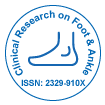Advances and Challenges in Foot and Ankle Research: Bridging the Gap between Biomechanics, Rehabilitation, and Clinical Practice
*Corresponding Author: Dr. Ananya Mehra, Department of Anatomy and Physiology, University of California, San Francisco (UCSF), USA, Email: ananya.mehra@gmail.comReceived Date: Mar 03, 2025 / Accepted Date: Mar 30, 2025 / Published Date: Mar 30, 2025
Citation: Ayesha P (2025) Advances and Challenges in Foot and Ankle Research:Bridging the Gap between Biomechanics, Rehabilitation and Clinical Practice. ClinRes Foot Ankle, 13: 632.
Copyright: © 2025 Ayesha P. This is an open-access article distributed under theterms of the Creative Commons Attribution License, which permits unrestricteduse, distribution, and reproduction in any medium, provided the original author andsource are credited.
Abstract
Foot and ankle disorders represent a signi ficant burden on global health, affecting millions of individuals across various age groups and demographics. While considerable progress has been made in understanding the biomechanics, pathology, and therapeutic approaches associated with these complex structures, many clinical and research gaps remain. This article explores recent advances in foot and ankle research, emphasizing biomechanics, rehabilitation strategies, surgical innovations, and the emerging role of technology. We also discuss current challenges and potential directions for future research aimed at enhancing patient outcomes and functional mobility. Foot and ankle disorders present a significant burden on global health, affecting mobility, quality of life, and economic productivity across diverse populations. Recent decades have witnessed substantial progress in the understanding of foot and ankle biomechanics, as well as in the development of innovative rehabilitation approaches and clinical management strategies. Yet, despite these advancements, a persistent disconnects remains between biomechanical research, rehabilitation science, and everyday clinical practice. This disconnect often hampers the translation of cutting-edge research findings into effective, patient-centered care. This review synthesizes current advancements in foot and ankle research with a focus on biomechanics, novel rehabilitation techniques, and evidence-based clinical interventions. It critically evaluates the integration of computational modeling, motion capture technologies, wearable sensors, and machine learning in understanding foot and ankle function. Furthermore, it explores the role of telerehabilitation, neuromuscular re-education, and patient-specific orthotic design in enhancing functional recovery. Key challenges identified include the heterogeneity of patient populations, limited cross-disciplinary collaboration, variability in clinical outcome measures, and the need for standardization in biomechanical assessments.

 Spanish
Spanish  Chinese
Chinese  Russian
Russian  German
German  French
French  Japanese
Japanese  Portuguese
Portuguese  Hindi
Hindi 
